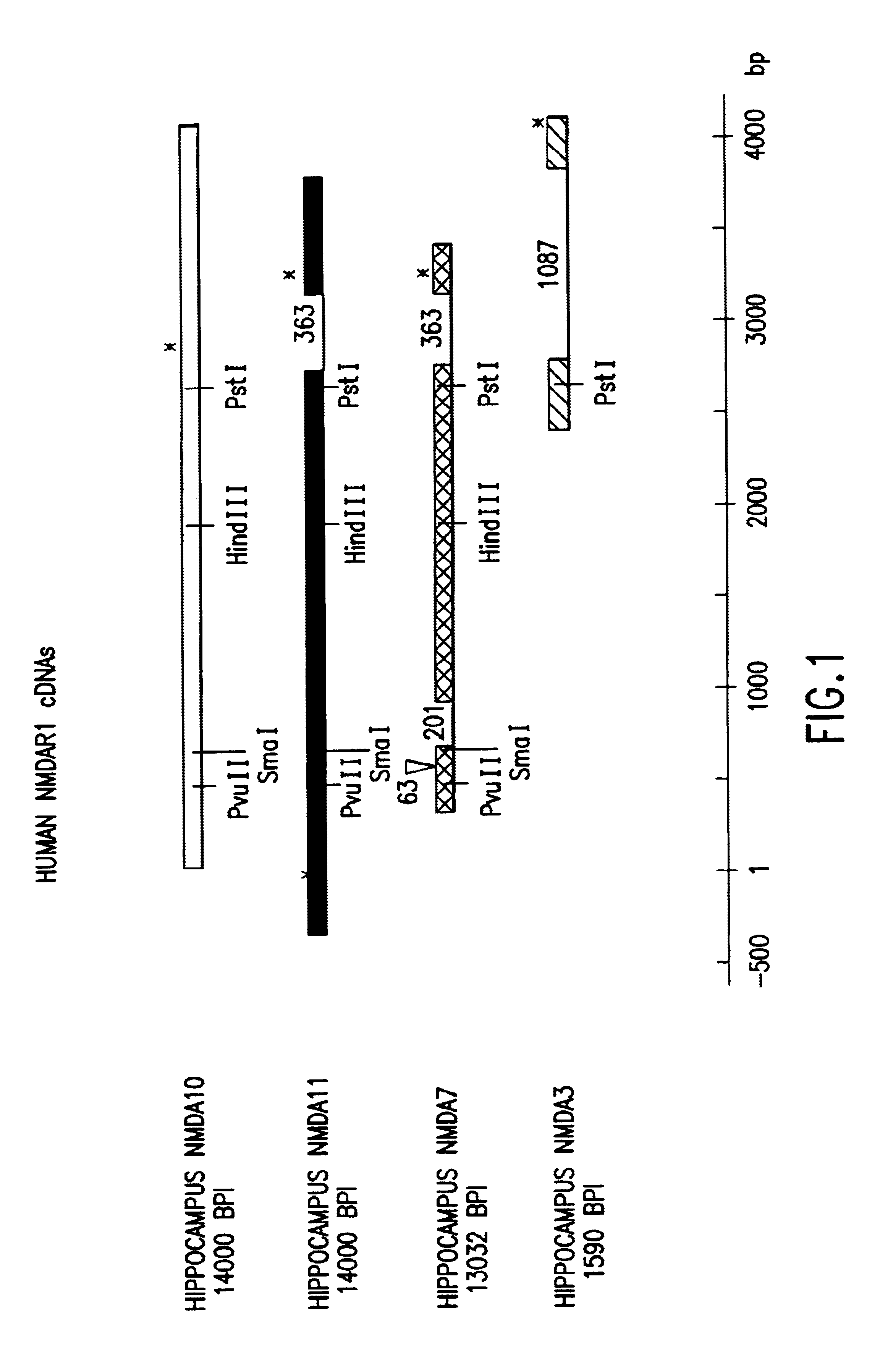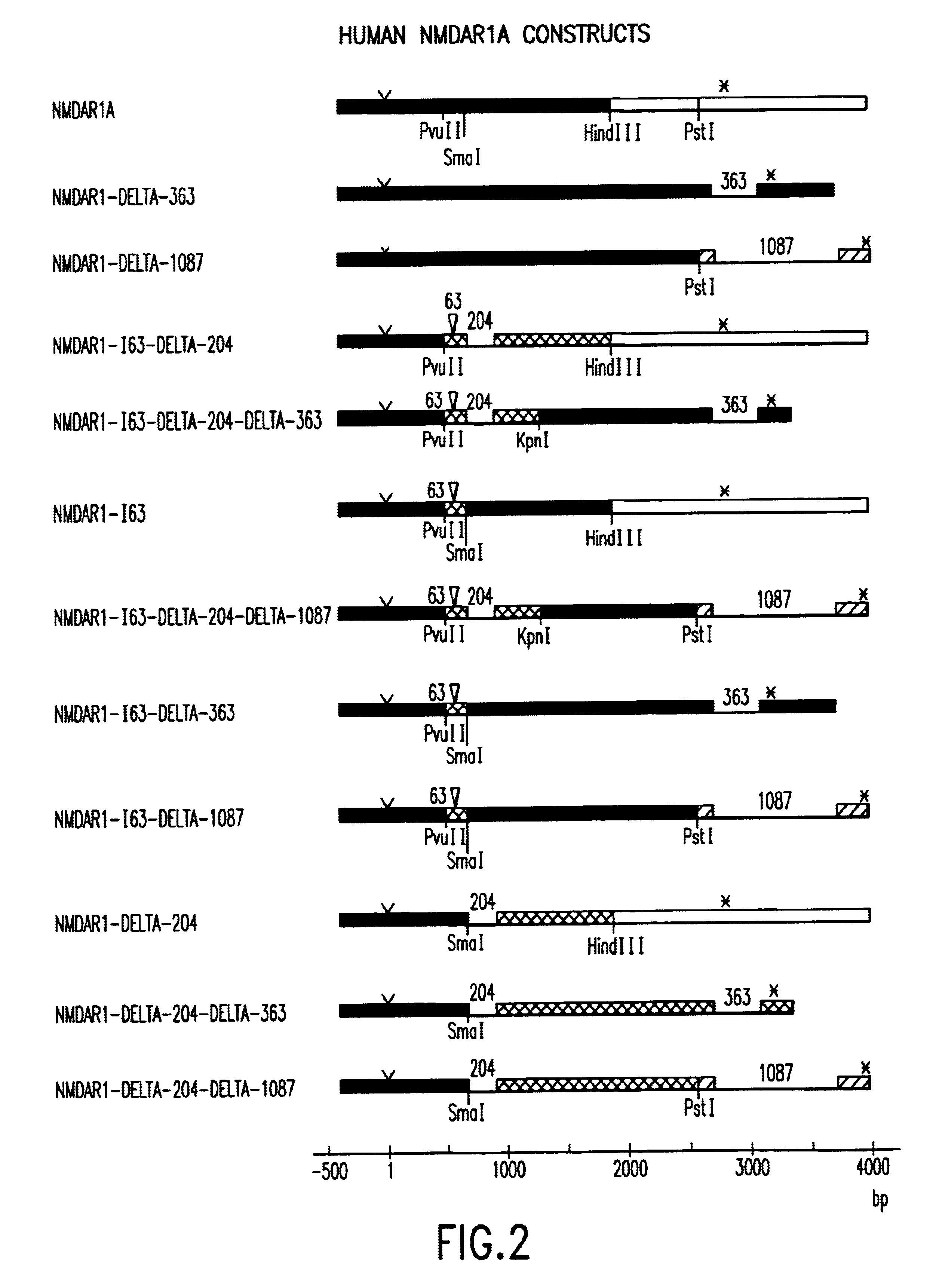Human N-methyl-D-aspartate receptor subunits nucleic acids encoding same and uses therefor
a technology of n-methyl-d-aspartate and receptor subunits, which is applied in the direction of receptors for neuromediators, immunoglobulins against animals/humans, peptides, etc., can solve the problem of limited application value of such studies to human therapeutics
- Summary
- Abstract
- Description
- Claims
- Application Information
AI Technical Summary
Benefits of technology
Problems solved by technology
Method used
Image
Examples
example 1
Isolation of DNA Encoding Human NMDA Receptor NMDAR1 Subunits
A. cDNA Library Screening
[0100]RNA isolated from human hippocampus tissue was used as a template for the synthesis of oligo dT-primed and randomly primed, single-stranded cDNA according to standard procedures [see, for example, Maniatis et al. (1982) Molecular Cloning: A Laboratory Manual, Cold Spring Harbor Laboratory Press, Cold Spring Harbor, N.Y.]. The single-stranded cDNA was converted to double-stranded cDNA, and EcoRI / SnaBI / XhoI adaptors were added to the ends thereof. The cDNAs were separated by size using agarose gel electrophoresis, and those that were >2.0 kb were ligated into EcoRI-digested λgt10 bacteriophage vectors. The resulting cDNA library was amplified by replication of each clone through limited infection of a bacterial host, and stored at −70° C.
[0101]The amplified hippocampus oligo dT-primed cDNA library was later retrieved from storage, and 1×106 recombinants were screened for hybridization to oligon...
example 2
Preparation of Full-length NMDAR1 Subunit cDNA Constructs
[0105]Portions of clones NMDA10, NMDA11, NMDA7 and NMDA3 were ligated together to construct full-length cDNAs encoding variants of the NMDA receptor NMDAR1 subunit. The full-length NMDAR1 subunit cDNAs were incorporated into vector pcDNA1 (Invitrogen, San Diego, Calif.) for use in expressing the receptor subunits in mammalian host cells and for use in generating in vitro transcripts of the DNAs to be expressed in Xenopus oocytes.
[0106]Vector pcDNA1 is a pUC19-based plasmid that contains the following elements in the 5′-to-3′ order: the cytomegalovirus (CMV) immediate early gene promoter / enhancer, the bacteriophage T7 RNA polymerase promoter, a polylinker, the bacteriophage SP6 RNA polymerase promoter, SV40 RNA processing (i.e., splice donor / acceptor) signals, SV40 polyadenylation signal, and the ColE1 origin and supF suppressor tRNA to permit maintenance of the vector in Escherichia coli strains with the P3 episome. This vecto...
example 3
Isolation of DNA Encoding Human NMDA Receptor NMDAR2C Subunits
[0133]Degenerate oligonucleotides were synthesized based on two conserved regions of rat NMDAR2A, NMDAR2B and NMDAR2C DNAs that encode the putative first and fourth transmembrane domains. In rat NMDAR2A DNA, these regions are encoded by nucleotides 1669-1692 (oligo SE74) and 2437-2465 (olig SE75), respectively. [see Monyer et al. (1992) Science 256:1217-1221]. These oligonucleotides were used to prime nucleic acid amplification of cDNAs prepared from RNA isolated from human hippocampus, cerebellum, and orbitofrontal tissue. Two products, a 795-bp and a 640-bp fragment, were detected when the reaction mixture was analyzed by gel electrophoresis and ethidium bromide staining. The 795-bp fragment amplified from the cerebellum cDNA was subcloned into PCR1000 (Invitrogen, San Diego, Calif.) and characterized by DNA sequence analysis, which revealed that it is ˜86% similar to the rat NMDAR2A DNA sequence, ˜78% similar to the ra...
PUM
| Property | Measurement | Unit |
|---|---|---|
| melting temperature | aaaaa | aaaaa |
| melting temperature | aaaaa | aaaaa |
| melting temperature | aaaaa | aaaaa |
Abstract
Description
Claims
Application Information
 Login to View More
Login to View More - R&D
- Intellectual Property
- Life Sciences
- Materials
- Tech Scout
- Unparalleled Data Quality
- Higher Quality Content
- 60% Fewer Hallucinations
Browse by: Latest US Patents, China's latest patents, Technical Efficacy Thesaurus, Application Domain, Technology Topic, Popular Technical Reports.
© 2025 PatSnap. All rights reserved.Legal|Privacy policy|Modern Slavery Act Transparency Statement|Sitemap|About US| Contact US: help@patsnap.com



